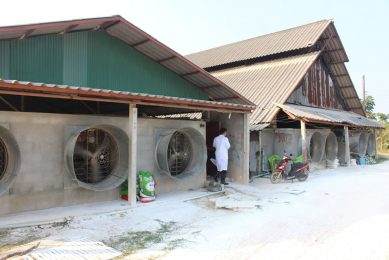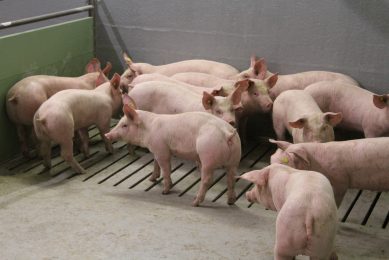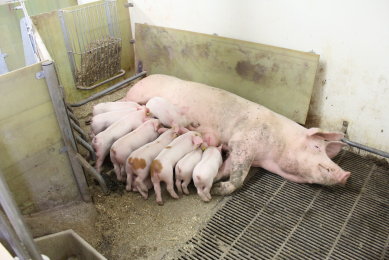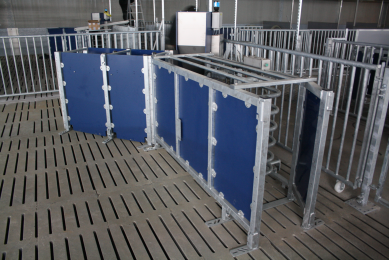68 ventilation basics

Working farmers do not realise the considerable amount of information a professional ventilationist must enter in to the computer before he/ she can design a system which will deliver the goods. There are in fact, a choice of 68 factors which must be provided. I list the most important of them below. Before I do so there are a few things which must be mentioned.
This article is not written for the producer who has the benefit of installing custom-made ventilation equipment in a standard set of buildings where the majority of the 68 factors are known in advance. But for the average producer with older buildings of all shapes and sizes where the ventilation needs attention or replacement.
Nearly all of my hundreds of ventilation ‘call-outs’ to such farms over the years have been where the alterations have not worked satisfactorily because some of the factors mentioned below were not taken into account.
Ventilation accuracy depends on the laws of physics and mathematics. A precise science – even more so than nutrition, which also has to be precise these days, but less so in terms of nutrient ingredients as these are so variable. Maths and physics laws are immutable!
So ventilation is a matter of ‘getting the sums right’ and the criteria below must be established before this can be done.
1. Details of buildings
- Length, width, height to ridge, height to eaves/ceiling.
- Pen dimensions: Type (solid or railed), length, width, height, number.
- Axis of building to the prevailing wind.
- Location (exposed or sheltered).
- Proximity of nearby buildings: Their height, length, width, and distance.
2. Building construction
- Full details of the materials of construction.
3. Floor
- Solid concrete, any insulation; slats, straw or other bedding/ depth, perforated plastic/ metal, earth.
4. Roof
- Outer skin, air gap, insulation, inner skin, materials, thickness.
5. Walls
- Panel walls: Outer skin, air gap, insulation, inner skin, material, thickness.
- Masonry walls: Single skin or double, material, thickness.
- Cavity walls: Outer skin, air gap, inner skin, material, thickness.
6. Fittings and obstructions
- The location and dimensions of fittings such as beams, roof trusses, protruding battens, lighting tubes when fixed to a surface, underdrawn ceilings, covers, purlins, feeders/ feed conveyors, feed and water pipelines, water tanks, type of drinkers and placement should be recorded.
7. Stocking details
- Number of pigs: Maximum, minimum, number per pen.
- Stocking policy: Continuous or all-in/ all-out.
- Live weight of pigs: In and out.
- Expected mean weight.
8. Feeding details
- Ad-lib or restricted (if restricted, six additional criteria to those below are required).
- Ad-lib: Pellets, meal, wet/dry, pipeline-fed, energy density of food.
9. Typical current performance
- Feed conversion ratio (FCR)/ Average daily gain (ADG) over the liveweight range.
10. Current ventilation
- Pressure or extraction, type/ make, number of fans per room, capacity, max/ min speed, diameter, housing, i.e. where placed, dimensions of outside wind baffles, controller details, number, type and placement of sensors.
Is all this data necessary?
Yes it is – for several reasons. From this data the ventilation engineer can add to the information he/she already has in the computer on typical meteorological/ climatic conditions in the farm’s locality and if needed consider the frequency of past extremes of temperature, wind speed and humidity in the locality and whether the ventilation capacity is worthwhile covering them. They can now provide…
- The thermal properties and heat losses from the structure as of now.
- What this is costing in predicted performance loss.
- What this is costing in lost income/ extra costs.
- A penalty cost figure (per pig, or per m2, or per year) to set against the cost of rectification. This is tremendously important as the cost of renewal or uprating the ventilation is always costly and producers can be deterred from doing all of what is really needed due to the expense. Omitting reliable sensors, controllers and fail-safe precautions.
- Guidance on what structural alterations may be needed and their cost, so as to allow any ventilation system to function to its maximum efficiency.
- Specifications to enable the farmer to ask any manufacturer/ installer to quote his best prices for equipment and installation.
- The specifications must be met. If not, refer the manufacturer to the ventilationist before purchase, as he may be able to design it in. If not, go to another supplier.
- This is the right, and I suggest the only way, to buy ventilation equipment.
[Source: Pig Progress magazine Vol 29 nr 8, 2013 – ‘What the textbooks don’t tell you about…’ series]











